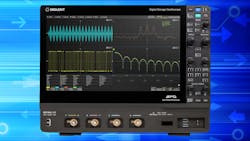Oscilloscope Offers Bandwidths Up to 4 GHz at 20 Gsamples/s
This article is part of the TechXchange: Oscilloscope Techniques.
Saelig released the Siglent SDS7000A series of high-bandwidth, high-resolution oscilloscopes to address increasing demand for advanced testing of next-gen electronic products. The series consists of two models, the SDS7404A (4 GHz) and SDS7304A (3 GHz).
Features include a sampling rate of 20 Gsamples/s, 12-bit vertical resolution, and 500 Mpoints per channel memory, with 12-bit analog-to-digital (ADCs) to limit quantization errors to aid in observing small signal details. The noise floor is as low as 220 μV rms at 4-GHz bandwidth, and the waveform capture rate reaches 1 million waveforms/s, with 16 digital channels for high-performance mixed-signal analysis.
The SDS7000A scopes also have a 15.6-in. high-definition touchscreen for analyzing all signal channels simultaneously and improving operational efficiency. They support multiple automatic parameter measurements, e.g., jitter and eye characterization, and embedded compliance test solutions to evaluate systems against communication standards such as USB 2.0, 100Base-TX, 1000Base-T, 100Base-T1 and 1000Base-T1.
Users can configure the test items, enabling software to control the oscilloscope to automatically complete the defined test, as well as automatically provide signal test results (Pass/Fail) after comparison with reference standards. The trigger system supports multiple triggering modes, including serial bus triggering.
Tools such as History waveform recording, Search and Navigate functions, Signal Scan, Mask Test, Bode Plot, Power Analysis, Eye/Jitter Analysis, and Compliance Test allow for capture, storage, and analysis of extended waveform records. The SAP5000D 5-GHz active differential probe enables detailed signal analysis, with a high input resistance and low input capacitance to ensure the load is minimized. The probes don’t require an additional external power supply and are automatically recognized by the oscilloscope via an intelligent SAPBus interface.
Links:
About the Author
Alix Paultre's Archive
Editor-at-Large
Also check out Alix's main author page for his latest articles.
An Army veteran, Alix Paultre was a signals intelligence soldier on the East/West German border in the early ‘80s, and eventually wound up helping launch and run a publication on consumer electronics for the US military stationed in Europe. Alix first began in this industry in 1998 at Electronic Products magazine, and since then has worked for a variety of publications in the embedded electronic engineering space. Alix currently lives in Wiesbaden, Germany.
Also check out hjis YouTube watch-collecting channel, Talking Timepieces.

